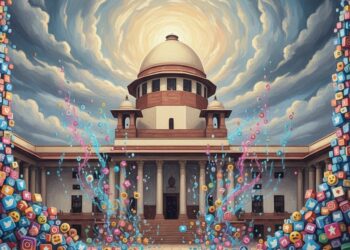When a certain website with pornographic content was ordered to shut shop, the debate whether the government had the right to slap such an order under the existing law came raging ahead. But then, it is not just a question of whether or not the existing law allows the government to take such a step, but whether or not the state has the right to act as the moral guardian of the people at all.
Is pornography detrimental to the public good to the extent of requiring state intervention and regulation? If pornography is wrong, what kind of wrong it is? If sexuality is natural, why should the law stand against natural human inclinations and ban content depicting sexual act? Why do natural instincts come in conflict with the moral values of a society? And why should the principles of morality be preferred over natural human instincts and desires?
These questions have to be answered in order to supply the required moral ground to the laws that seek to regulate pornography in any form. The distinction between erotica and sleaze, lust and desire, lovemaking and carnal sex must also be understood the same way as the difference between a connoisseur of cuisines and a glutton is understood. The issues involved, both legal and moral, are a little too complex because they are fundamentally about the longstanding battle between reason and instincts that continues to be at the very heart of all moral debates. If only one of the two had existed, we would possibly never face a moral dilemma, for it is doubtful if we would even have any moral values to start with.
The sense of decency and the idea of justice are the natural byproducts of man’s social and cultural evolution. Restraints on man’s natural instincts are not simply ‘symbolic’ of his cultural evolution, but are completely functional, as they keep man from reverting into a coarse bunch of disorderly instincts. This explains why all religions preach selflessness and self-restraint.
 Natural instincts come in conflict with social and ethical norms of the civilized world because they are fiercely individualistic with self-preservation and perpetuation of one’s own kind as its central objectives. Since instincts have no content of rationality, they do not recognize the concept of human development through mutual cooperation, or, for that matter, of a culturally evolved existence. Therefore, the drive to preserve oneself and to perpetuate one’s kind through procreation comes naturally; and, being primordial, it is extremely powerful. Sexual conduct and misconduct is, therefore, instinctual in nature. Whether a certain sexually inclined act falls within the description of ‘misconduct’ or not has to be seen against the social and cultural backdrop of the society and people concerned.
Natural instincts come in conflict with social and ethical norms of the civilized world because they are fiercely individualistic with self-preservation and perpetuation of one’s own kind as its central objectives. Since instincts have no content of rationality, they do not recognize the concept of human development through mutual cooperation, or, for that matter, of a culturally evolved existence. Therefore, the drive to preserve oneself and to perpetuate one’s kind through procreation comes naturally; and, being primordial, it is extremely powerful. Sexual conduct and misconduct is, therefore, instinctual in nature. Whether a certain sexually inclined act falls within the description of ‘misconduct’ or not has to be seen against the social and cultural backdrop of the society and people concerned.
The legal ambit of acceptable sexual conduct is quite understandably smaller in scope and expanse than the social and cultural norms pertaining to decency, which leaves sufficient grey area for such conduct that is not strictly illegal but is not completely acceptable either. Pornography falls in this area, which is why the laws governing pornographic content both online and offline vary a great deal from one part of the world to other and the extent of restriction ranges from total ban to almost no-ban situations.
The Internet, with its ever-increasing penetration and convenience of use coupled with the extreme difficulties involved in monitoring website content, has become the most prominent carrier and disseminator of pornographic content.
Pornography is generally understood as explicit portrayal of sexual acts for the purpose of sexual stimulation. The natural purpose of sexual act is procreation and the pleasure derived from the act has possibly been provided by nature as a motivation for human beings to act towards preservation and propagation of their own kind. The desire to reproduce is not exclusive to human beings, but to use sex as entertainment certainly is.
 The kind of pornography that generally falls foul with the law across the world is such form of perverse sexual entertainment that has no purpose other than pandering to the prurient human tendencies.
The kind of pornography that generally falls foul with the law across the world is such form of perverse sexual entertainment that has no purpose other than pandering to the prurient human tendencies.
In India, Section 292 of the Indian Penal Code, 1840, prohibits the printing, sale and distribution of ‘obscene books’ and material and defines those thus: “…a book, pamphlet, paper, writing, drawing, painting, representation, figure or any other object, shall be deemed to be obscene if it is lascivious or appeals to the prurient interest or if its effect, or (where it comprises two or more distinct items) the effect of any one of its items, is, if taken as a whole, such as to tend to deprave and corrupt persons who are likely, having regard to all relevant circumstances, to read, see or hear the matter contained or embodied in it.]
However, the Exception to the provision expressly excludes such content that “is in the interest of science, literature, art of learning or other objects of general concern”. The Exception also expressly protects depictions on ancient monuments and temples allowing religion and culture to have its take on sex and the associated issues.
The Exception clearly demonstrates that the law leaves sufficient room for artistic, scientific and religious endeavours that might be erotic in nature. What it seeks to proscribe is depiction of sexually explicit material for the sole purpose of pleasure. In other words, the law is against sex as entertainment.
The spirit of the pornography law remains intact in the Information Technology Act, 2000, which applies to website content. The provisions under the IT Act use the same terminology as used under the IPC and retain the same exceptions.
It is, therefore, evident that in India so long as sexual depictions are directed towards any goal other than entertainment, it is permissible. But if the purpose is sexual enjoyment or stimulation alone, the content would face the axe unless it could be shown to have some artistic value.
In the United States, the legal position of Internet pornography is not uniform across the various states with many states having banned the making and distribution of adult films putting such activity in the category of prostitution. For the purpose of deciding whether the material under question is obscene and deserves to be banned, Miller’s Test laid down by the US Supreme Court in the 1973 case Miller v. California is employed. It is this decision of the Supreme Court that allowed the States to make their own laws to regulate pornography. According to the three pronged Miller’s Test, what needs to be considered is:
1. Whether the average person, applying contemporary community standards, would find that the work, taken as a whole, appeals to the prurient interest,
2. Whether the work depicts/describes, in a patently offensive way, sexual conduct or excretory functions specifically defined by applicable state law,
3. Whether the work, taken as a whole, lacks serious literary, artistic, political or scientific value.
The use of the expression ‘contemporary community standards’ amply demonstrates that the standards of decency may vary from one part of the country to another even in a relatively homogenous country like the US. However, at the same time, the spirit of the pornography law in India as reflected in the relevant provisions of the IPC and that in the US, as evident from Miller’s Test and other laws, remains much the same despite the vast social, economic and cultural differences between the two nations.
Therefore, it is easy to conclude that although to judge what is obscene may, to some extent, require a social and cultural context, but pornography is tolerated at best with law outlining the extent of such toleration. Pornography is, thus, a grudging concession.
And Savita Bhabhi?
 Savita Bhabhi is an Indian cartoon pornographic website featuring the sexual escapades of an Indian housewife by the name Savita in explicit graphic detail. The lady has no moral hang-ups regarding her illicit liaisons and is also equally comfortable with salesmen, young boys living in the neighbourhood and her own cousin, not to speak of her husband’s friends. There is no real story, no conflict situation and no character development worth the name. In short, the raunchy stories have no literary inclinations. Mrs. Savita Patel’s sexual exploits are not only adulterous but also border on incest, and she remains remorseless about them and does it all with unreal abandon. Naturally, her human self and the social setting she operates in has been conveniently taken out of the equation to allow as much room as possible to raw lust turning Savita into a sex doll instead of a real character.
Savita Bhabhi is an Indian cartoon pornographic website featuring the sexual escapades of an Indian housewife by the name Savita in explicit graphic detail. The lady has no moral hang-ups regarding her illicit liaisons and is also equally comfortable with salesmen, young boys living in the neighbourhood and her own cousin, not to speak of her husband’s friends. There is no real story, no conflict situation and no character development worth the name. In short, the raunchy stories have no literary inclinations. Mrs. Savita Patel’s sexual exploits are not only adulterous but also border on incest, and she remains remorseless about them and does it all with unreal abandon. Naturally, her human self and the social setting she operates in has been conveniently taken out of the equation to allow as much room as possible to raw lust turning Savita into a sex doll instead of a real character.
Adultery is a criminal offence in India and the very idea of incest is extremely offensive to the Indian mindset, to say the least. Whether the relevant Indian law is employed or the Miller Test, Savita Bhabhi would find it hard to wriggle through the legal net.
Furthermore, the name ‘Savita Bhabhi’ itself is offensive because ‘bhabhi’ means elder brother’s wife (sister-in-law) in Hindi and Hindustani. The way it is used in the Savita Bhabhi stories, it automatically takes on a sexual hue, which certainly would not be acceptable to an ‘average’ Indian ‘applying contemporary community standards’. The content certainly has the tendency to ‘deprave and corrupt’, for glorification of adultery and incest can only be seen as inspiring and endorsing extreme sexual depravity.
The argument of ‘private conduct’ and of minimal state interference in citizens’ private lives is not an iron defence in this regard because although accessing pornographic material in private remains within one’s private domain, but its influence on the mind of the person concerned remains and carries into his social life. Besides, there is a clear danger of underage boys accessing such material, and the ill-effect of such depictions on their very impressionable minds can be devastating not only for them, but also for the society. Therefore, when Savita Bhabhi was ordered to pack her bags, the government did the right thing. Savita Bhabhis must go.
Originally written for and published in LAWYERS UPDATE as Cover Story [April 2010 Issue; Vol. XVI, Part 4]





